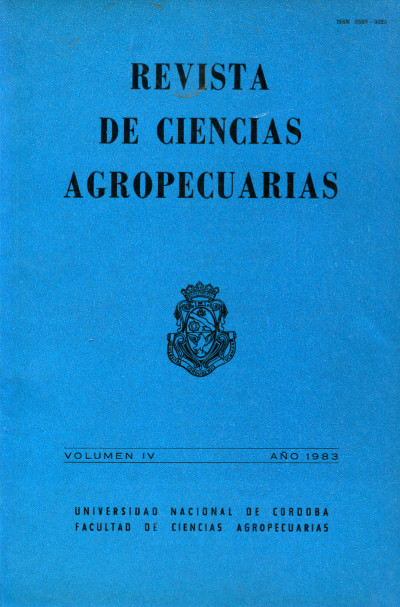Study of different methods of estimating cold hours and their comparison with the actual computation of the same obtained in Cordoba
Main Article Content
Abstract
Article Details
How to Cite
References
BIDABE, B. 1967. Action de ]a temperature sur 1'evolution des bourgeons de pommier et comparaison de méthodes de controles de 1' poque de floraison. Ann. Physiol. Vegét. 9(l):65-86
BOYNTON, D. 1959. Observations on the temperature limitations of the apple in Tropical America Proc. of the Caribean Region. A.S.H.S. VII Meeting. p.69-81.
CROSSA-RAYNAUD, P. 1956. Effects des hivers doux sur le comportement eles arbres fruitier a feuille s caduques. Ann. Serv. Bot. Agron. 29:1-22.
CHANDLER, V. et al. 1937. Chilling requirements for opening of buds on deciduous orchard trees and some other plant9 in California. Univ. of Calif. Agrie. Exp. Sta., Berkeley, Bull. 611.
HATCH, A. 11. and D. R. WALKER 1969. The effect of temperature on cold hardiness, respiration and intensity of rest of dormant peach and; apricot buds. Published with the approval of the Director of Research as Paper No
839 of the journal Series.
DAMARIO, E. A., 1968. Carta estimada de horas de frío de la República Argentina. Rev. de la Fac. ele Agronomía y Veterinaria de Buenos Aires. 17(2):25-38.
DA MOTA, F. S. 1957. Os invernos de Pelotas, Bs, em relapáo as exigencias das al)'o-es frutileras de folhas caducas. Bol. Tee. N" 18 do Instituto Agronomico do Sol.
MARKUS, R. 1952. Um estudo estatistico dos invernos de Porto Alegre en rela(:Io as exigencias de frío das frutíferas de clima temperado; Revista Agronomica. Año XVI, N" 187; 88-89. Porto Alegre.
MUÑOZ SANTA MARIA, G. 1968. Evaluación de fórmulas para el cálculo de horas-frío en algunas zonas fruticolas de México. Banco Nación Agropecuario. S.A. México.
NIGHTINGALE, G. T. y M. A. BLAKE. 1934. Effects of temperature on the growth and composition of Satyman and Bladwin apple trees. N. S. Agr. St. Bull. 566.
SAMISII, R. M. and S. LAVEE. 1962. The chilling requirement of fruit trees. XVI Int. Hort. Cong. Brussells, pp. 372-388.
WEINBERGER, J. H. 1950. Chilling requirements if peach varieties. Amer. Soc. For. Hort. Sci. Proc. 56:122-127.





